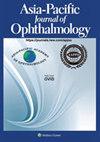替代生长激素治疗对中国儿童近视控制的影响。
IF 4.5
3区 医学
Q1 OPHTHALMOLOGY
引用次数: 0
摘要
目的:探讨重组人生长激素(rhGH)治疗与近视进展的关系,优化接受rhGH治疗的近视儿童的近视控制策略。方法:回顾性研究27例接受rhGH治疗的近视儿童和对照组57例接受近视干预的近视儿童。睫状体麻痹后用IOLMaster和自折射仪测量轴长(AL)和屈光。比较rhGH组与对照组、rhGH治疗前后以及不同近视控制策略之间AL的变化。单变量和多变量回归模型分析了与轴向伸长相关的因素。结果:rhGH组AL的中位数变化大于对照组(0.29 mm/年;四分位间距[IQR], 0.19-0.40;N = 27 vs. 0.18 mm/年;差,0.12 - -0.27;n = 57;P 结论:尽管近视得到控制,但接受rhGH治疗的近视儿童仍会出现加速的眼轴伸长。建议对这些儿童采取密切监测和双重治疗的近视控制策略。本文章由计算机程序翻译,如有差异,请以英文原文为准。
Effect of substitutive growth hormone therapy on myopia control among Chinese children
Purpose
To explore the correlation between recombinant human growth hormone (rhGH) therapy and myopia progression, and to optimize the myopia control strategies in myopic children undergoing rhGH therapy.
Methods
This retrospective study included 27 myopic children receiving rhGH therapy and 57 myopic children in the control group, all of whom underwent myopia interventions. Axial length (AL) and refraction were measured by IOLMaster and an autorefractor after cycloplegia. AL changes were compared between the rhGH and control groups, before and after rhGH therapy, and among different myopia control strategies. Univariate and multivariate regression models analyzed factors associated with axial elongation.
Results
The rhGH group exhibited greater median AL change than the control group (0.29 mm/year; interquartile range [IQR], 0.19–0.40; n = 27 vs. 0.18 mm/year; IQR, 0.12–0.27; n = 57; P < 0.001). Median axial elongation increased after rhGH treatment (0.22 mm/year; IQR, 0.12–0.34 vs. 0.32 mm/year; IQR, 0.26–0.40; n = 14; P = 0.026), while it decreased after cessation (0.39 mm/year; IQR, 0.16–0.56 vs. 0.04 mm/year; IQR, –0.03–0.15; n = 6; P = 0.031). After adjusting for confounders, axial elongation was faster in the rhGH group (β = 0.13, P < 0.001). Longer rhGH therapy duration and shorter myopia control duration were associated with accelerated axial elongation (β = 0.13, P = 0.027). Dual-therapy myopia control appeared to mitigate excessive axial elongation in rhGH-treated children more effectively than monotherapy (0.27 mm/year; IQR, 0.18–0.31; n = 20 vs. 0.40 mm/year; IQR, 0.32–0.70; n = 7; P = 0.026).
Conclusions
Myopic children undergoing rhGH therapy would exhibit accelerated axial elongation despite myopia control. Close monitoring and dual-therapy myopia control strategies are recommended for these children.
求助全文
通过发布文献求助,成功后即可免费获取论文全文。
去求助
来源期刊

Asia-Pacific Journal of Ophthalmology
OPHTHALMOLOGY-
CiteScore
8.10
自引率
18.20%
发文量
197
审稿时长
6 weeks
期刊介绍:
The Asia-Pacific Journal of Ophthalmology, a bimonthly, peer-reviewed online scientific publication, is an official publication of the Asia-Pacific Academy of Ophthalmology (APAO), a supranational organization which is committed to research, training, learning, publication and knowledge and skill transfers in ophthalmology and visual sciences. The Asia-Pacific Journal of Ophthalmology welcomes review articles on currently hot topics, original, previously unpublished manuscripts describing clinical investigations, clinical observations and clinically relevant laboratory investigations, as well as .perspectives containing personal viewpoints on topics with broad interests. Editorials are published by invitation only. Case reports are generally not considered. The Asia-Pacific Journal of Ophthalmology covers 16 subspecialties and is freely circulated among individual members of the APAO’s member societies, which amounts to a potential readership of over 50,000.
 求助内容:
求助内容: 应助结果提醒方式:
应助结果提醒方式:


